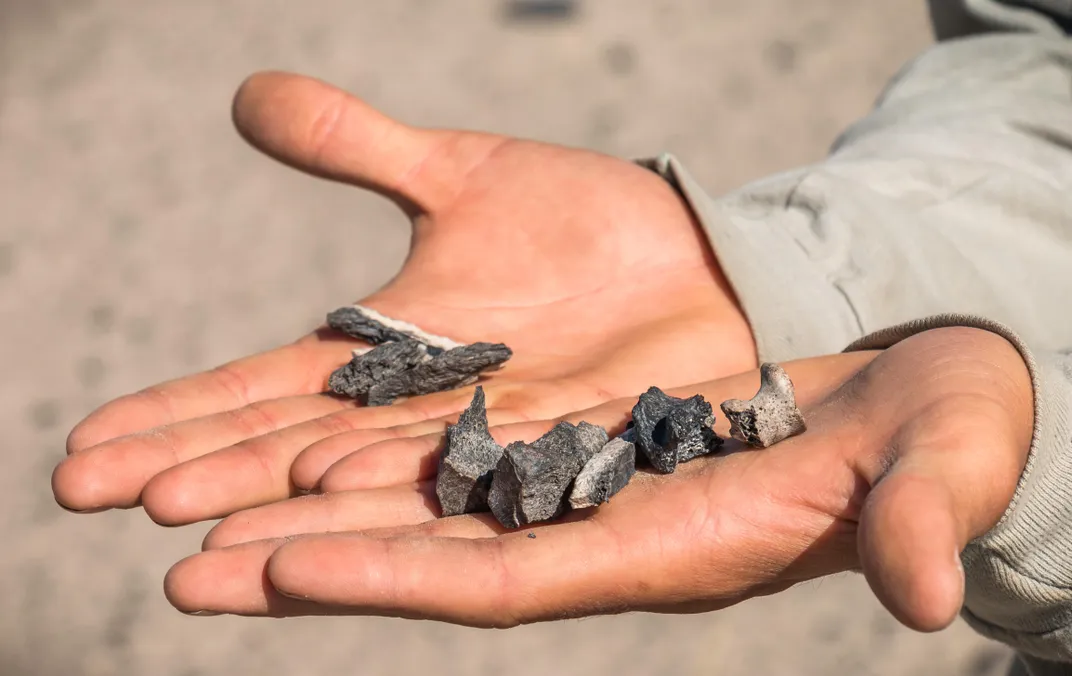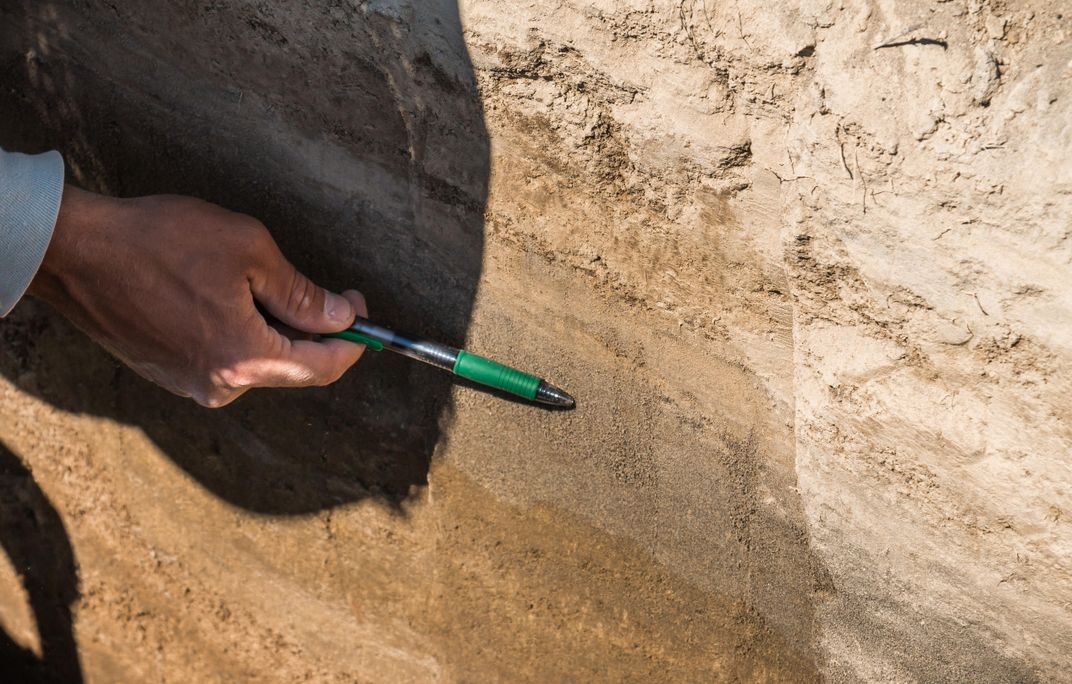Rare Mammoth Tracks Reveal an Intimate Portrait of Herd Life
Researchers piece together a 43,000-years-old tableau of an injured adult and concerned young
/https://tf-cmsv2-smithsonianmag-media.s3.amazonaws.com/filer/7c/6b/7c6b33f9-fe8b-4005-b80d-6200c1f2fe1f/mammoth3.jpg)
The dinner plate-sized impressions were barely discernible. When he first spotted them in the dust of the dry lakebed, paleontologist Gregory J. Retallack and his students didn’t think much. But upon closer inspection, what looked like four or five prints partially covered in sand turned out to be a winding section of 117 tracks. These tracks, they would later learn, were left 43,000 years ago by six Columbian mammoths: four adults, a youngster and an infant on a curious journey.
This was a big deal—a mammoth one, you might say. Aside from studying living elephants, most of what we know about mammoths from physical characteristics to diet, comes from their skeletal remains. Yet social behavior is more challenging to tease out, and ancient trackways are one of the few windows in. These prints had captured an intimate moment between an injured adult female and concerned young, offering an unprecedented peek into the world of mammoth herd life.
The group came upon the tracks in April 2014, during the annual fossil hunting trip Retallack organizes for his students at the University of Oregon. They had already found fossils at several sites when he decided to swing by Fossil Lake. This dry, barren lakebed is known for its fossil riches; the remains of creatures up to 646 thousand years linger in its dusty layers, including birds, fish, mollusk and even mammals like camels, ground sloths and mammoths.
Retallack, the director of paleontological collections at University of Oregon's Museum of Natural and Cultural History, had just instructed the class to spread out and begin their search when he spotted the circular marks. "Those look like mammoth tracks to me," Retallack recalls telling the students standing nearby.
The students weren’t so impressed. "I don't think they even believed me," he says now. But the tracks stuck in his mind.

Three years later, Retallack obtained the funding to return with a team of researchers from the university, the Bureau of Land Management, and the University of Louisiana at Lafayette to unearth and analyze the prints. They dusted away the sand and, using both ground-based and drone-mounted cameras, took detailed images of the area. By compiling these images, the team created a three-dimensional digital model to tease out the elephant vignette recorded in mud. The researchers also dug a pit nearby to study the sediment layers, publishing their findings earlier this month in the journal Palaeogeography, Palaeoclimatology, Palaeoecology.
Their analysis suggests that the creatures were Columbian mammoths, a species that tromped from Canada to modern Nicaragua starting nearly a million years ago. Standing slightly taller than modern African elephants, the creatures had massive tusks up to 16 feet long. Unlike their wooly cousins, Columbian mammoths are thought to have sported a much more sparse coat of fur—perhaps even only having a mop top of coarse hair on their heads. They are believed to have gone extinct some 10,000 years ago, though the exact cause of their demise remains a mystery.
The main trackway at the site extends for 65 feet. But there’s something strange about it: Unlike other known ancient mammoth trails, the footprints are closely spaced and the right side is much deeper than the left; the left rear foot tracks are particularly faint. "We know a lot about elephant tracks. We have a lot of them going back in the fossil record going back 16 million years or more," Retallack says. "Mostly the elephants are striding out like a sergeant major in a parade."
Not these pachyderms. The unusual footprints, the researchers believe, are due to an injury in the animal’s left rear leg that caused the animal to move slowly and limp, in an effort to ease the pain.
That’s an impressive amount of information to draw from one set of tracks. But Lisa Buckley, a vertebrate paleontologist at the Peace Region Palaeontology Research Centre in northeast British Columbia who specializes in interpreting ancient animal tracks, agrees. The consistency of the surface around the footprints, she says, suggests that the unusual spacing and differences in depth were from the track maker's hobbled stride, rather than variation in the mud itself.

Crisscrossing the site are smaller trackways—roughly the size of a bowling ball or smaller—that appear to be made by two young creatures: a juvenile mammoth between one and three years old, and a baby less than a year old. The tracks suggest that these youngsters were running ahead of the group, likely eager to get to the lake, which lay about a mile to the west of the slow-moving mammoth parade, says Retallack.
During their march, the tracks repeatedly return to the limping mammoth, as if the young were checking on the progress of their slow-moving companion. Upon each return, "there were little deflections where those trackways met," says Retallack. These hint that the injured creature was interacting with the young, much like the tender interactions that have been observed for African elephants, their modern relatives. As Buckley says, "it's very plausible that the young animals were coming up and going, 'Oh hey, how [are] you doing?'"
Those kind of interactions in turn suggest that the injured adult was a female, says Retallack. As he explains, mammoth herds, like modern elephants, are thought to have moved in matriarchal groups, led by an older female. "Once the males reach the age of somewhere between 10 and 15 they get kicked out of the herd," says Advait Jukar, vertebrate paleontologist with Smithsonian's National Museum of Natural History who was not involved in the latest study. "They form these bachelor groups and they go off and do their own thing."
One striking mammoth track site that shows these herding behaviors can be found in the United Arab Emirates, says Jukar. The site records trackways of a herd of at least 13 ancient elephant relatives thought to be gathered in a matriarchal herd, with one lone male blazing a trail of large round tracks that cut across the herd's path.
If the lead elephant at the Fossil Lake site was male, it would be too young to have sired any babies, Retallack explains, and would likely be indifferent to the little honkers gambling about. "We of course can't be 100 percent sure, because all we're dealing with is the trackway," Jukar says of the new study. "But it's a reasonable hypothesis to make."
The chances of finding a collection of tracks like this are exceedingly rare, and rely on the rapid preservation of footprints before wind or rain can obscure the impressions. Even when that does happen, most tracks merely record what animals do for most of the day: "Walking from point A to point B, usually in a straight line," says Buckley. "It's so uncommon to get these other types of behaviors in footprints that we often make the jokes that dinosaurs couldn't turn. We [find] so many straight trackways."
The Fossil Lake tracks mark a fortuitous coincidence of weather, geology and a mammoth herd passing by. The footprints are etched into sediments rich with volcanic ash, likely remnants of an explosion from Mount Saint Helens in present-day Washington 43 thousand years ago. The ash blanketed the region, turning what was once a grassland into a more barren, muddy expanse—a surface ripe for trackways.
Between the wind, ash and sediment from streams, the mammoth tracks were likely quickly covered. Over tens of thousands of years, the team's soil analysis suggests, the region transitioned back to grassland and then again to the more barren landscape present today. The last transition may be due, in part, to the extinction of mammoths and other big grazers, Retallack explains, which supplied nutrients in their dung and kept the grasses healthy by trampling and munching on it.
The Fossil Lake mammoth prints, it seems, are just one chapter in the larger story of dramatic ecosystem-level changes. "It's a lot from a single trackway, isn't it?" marvels Retallack. "I was kind of surprised myself."
/https://tf-cmsv2-smithsonianmag-media.s3.amazonaws.com/accounts/headshot/Wei-Haas_Maya_Headshot-v2.png)
/https://tf-cmsv2-smithsonianmag-media.s3.amazonaws.com/accounts/headshot/Wei-Haas_Maya_Headshot-v2.png)